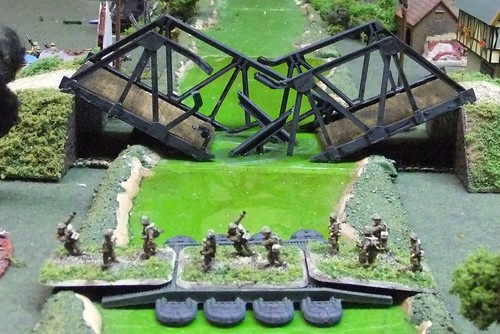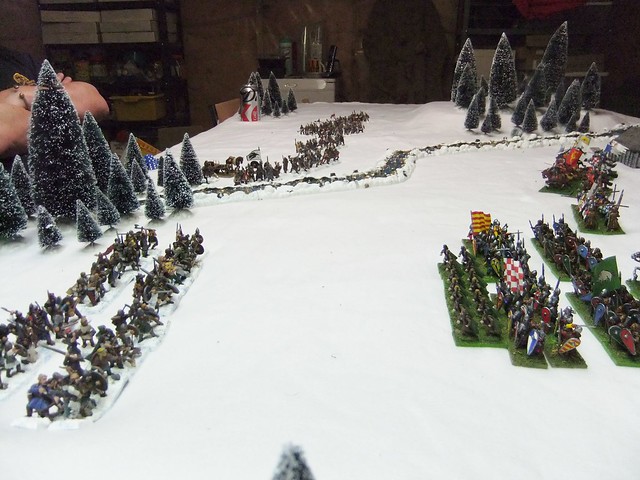It's all Scott's fault.
We were happily playing some I Ain't Been Shot, Mum a few weeks ago. My Canadian Sherman troop was advancing to be ambushed by his StuGs and he has to point out that my Old Glory Sherman Fireflies have cast hulls and the Canadians only got the welded hulls.
Now my lovely Sherman troops were like ashes in my mouth. With a problem of such Gordian complexity what was I to do except loose sleep?
So I went to my friends, who are much more well read on the arcane technicalities of such things and asked them. I'm not a tread head or rivet counter by any means, but I do like to try and get the look of the thing right, if I can... without too much fuss or expense.
Much emailing ensued and 30 messages later it boiled down to this:
Apparently what I have are Firefly 1Cs. And the 1Cs were issued to Canadian armoured units in Italy and even used as replacements in Normandy. (The numbers of tanks knocked out in Normandy meant that the RCEME units were sending whatever they could fix back to the front and the tank squadrons were happy to get them! So any version of the Sherman would be appropriate.)
Another suggestion was to take the turrets off and turn them into Grizzly (the Canadian licence built version of the M4) Kangaroos to tow 17 pounder AT guns.
I would like some Kangaroos.
With the Plastic Soldier Company M4A4 and Firefly set on order for the store I realized I could get two boxes and that would give me enough to bring my Canadian armour up to a full squadron, even if I did turn the 1Cs into Kangaroos. Four troops of Shermans and Kangaroos! Visions of Operation Totalize danced in my head.
And finally after it all settled down I realized I could just swap the turrets with some of my M4A4s.
Now to figure out how to make the empty turret ring on the Old Glory model look like the troop compartment of a Kangroo....
....and get them some 17 pounders to tow!
Thursday, August 30, 2012
Wednesday, August 29, 2012
Afghan Dreams
When I go out with the cadets to train, we sometimes use a facility called Peacekeeper Park. In the meal hall there is a portrait of every Canadian service person killed in action over the last 10 years. Each time we go, the line of portraits is a little bit longer. After reading a lot about the Canadian army in the Boer War, WW1 and WW2 I realized that I had not yet read anything beyond a few newspaper pieces about our recent fighting in Afghanistan. I've encountered a few servicemen who have been to Afghanistan and I find myself wondering about their unspoken experiences and thinking that I just don't understand. So I set myself off to the library to rectify this gap in my knowledge.
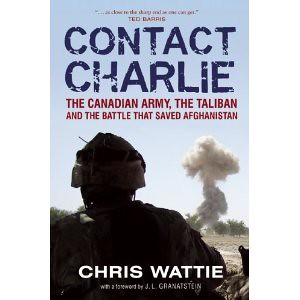 Contact Charlie; the Canadian Army, the Taliban and the battle that saved Afghanistan by Chris Wattie (Key Porter Books Ltd. 2008). This book covers the actions undertaken by Task Force Orion (built around 1st bn Princess Patricia's Canadian Light Infantry) in 2006. The title might seem a bit hyperbolic, but it comes from the regional commander's own assessment of the strategic worth of the operation. What started out as counterinsurgency patrols around Kandahar and in the Panjwayi district of southern Afghanistan turned into the biggest fighting Canadian soldiers had found themselves in since Korea as the men and women of TF Orion uncovered and disrupted a major Taliban buildup in the Panjwayi. This build up was aimed at attacking and occupying Kandahar City to get international press and break the political will of NATO and their voters at home, much the same as the Tet Offensive had done during the Vietnam War many years ago.
Contact Charlie; the Canadian Army, the Taliban and the battle that saved Afghanistan by Chris Wattie (Key Porter Books Ltd. 2008). This book covers the actions undertaken by Task Force Orion (built around 1st bn Princess Patricia's Canadian Light Infantry) in 2006. The title might seem a bit hyperbolic, but it comes from the regional commander's own assessment of the strategic worth of the operation. What started out as counterinsurgency patrols around Kandahar and in the Panjwayi district of southern Afghanistan turned into the biggest fighting Canadian soldiers had found themselves in since Korea as the men and women of TF Orion uncovered and disrupted a major Taliban buildup in the Panjwayi. This build up was aimed at attacking and occupying Kandahar City to get international press and break the political will of NATO and their voters at home, much the same as the Tet Offensive had done during the Vietnam War many years ago.
The book is quite good and reads like the Mark Zuehlke books about WW2 that I like so much; deftly moving from the overarching strategic situation and the decisions made by Generals and Colonels to a squad leader wondering what's around the next mud brick corner or a rifleman firing his C7 in a grape field. The actions at Bayanzi (in which Capt. Nichola Goddard's FOO LAV was struck by an RPG, killing her and causing much hand wringing in the press), Seyyedin, Pashmul and the White Schoolhouse are covered in a lot of detail.
The difficulties of the close terrain of the highly cultivated Panjwayi are well described. Grape drying huts, thick walled and impervious to most fire, are common and provided the Taliban with ready made strong points. The Canadian troops suffered as many heat casualties as wounds from enemy fire and mines. In the attack on the White Schoolhouse, two platoons ended up being just 18 men in a desperate firefight with over 10 times their number of insurgents and unable to call in artillery because the new NATO command wouldn't let them.
Now I find myself wondering how to recreate this on the tabletop.... sigh...
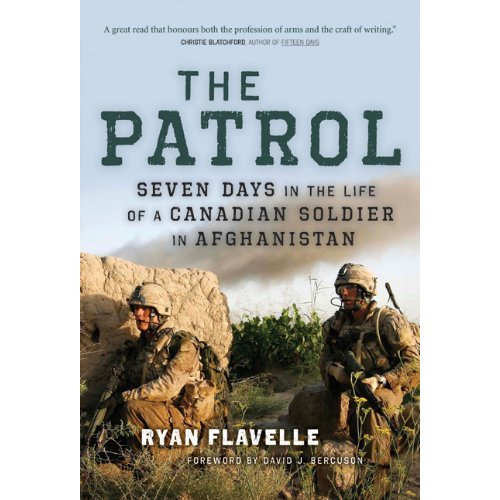 The Patrol; Seven Days in the Life of a Canadian Soldier in Afghanistan by Ryan Flavelle (Harper Collins Publishers Ltd. 2011). Is an excellent memoir by a young University of Calgary Grad student/reservist signaller who volunteered for an Afghanistan deployment, because as he naively thought; that's what soldiers do.
The Patrol; Seven Days in the Life of a Canadian Soldier in Afghanistan by Ryan Flavelle (Harper Collins Publishers Ltd. 2011). Is an excellent memoir by a young University of Calgary Grad student/reservist signaller who volunteered for an Afghanistan deployment, because as he naively thought; that's what soldiers do.
The writing is brilliant and captures these young men and what they are doing amazingly well with a prose that equals G.M. Frasers' Quartered Safe Out Here or Farley Mowat's And No Birds Sang. He describes the feelings of being on a night patrol lyrically and describes his own emotions forcefully. He and his companions joke about using explosives to make their hilltop Forward Operating Base look more like Castle Greyskull from the Masters of the Universe cartoon. I can relate to this nerdy, bespectacled university student feeling not-one-of-the-group in a small tight group of professional infanteers; his concerns with trying to keep up, not be weak and not look like a dork in front of his platoon are what keep him going. The lengthy section in which he describes packing his kit for the 7 day patrol makes illuminating reading; what to bring, what to put in which pouch, how much water he stows in various points around his tacvest and rucksack and how damn heavy it all gets. He attaches his bayonet to the bottom of his ruck, not because he expects to use it, but because: "On the very slim chance that we get ordered to fix bayonets (which has happened on previous tours), I don't want to be the idiot without a pointy gun."
The patrol does encounter some firefights and IED strikes. It is not the most intense action of his tour, but it is the first time under fire for him, and the patrol is for the authour a turning point. He tested himself and realized that he was scared, but not paralyzing scared, just scared in the sense that part of his brain was reminding him that if he had made better life choices he wouldn't be ducking from RPGs and machine gun fire behind a mud wall. He has a lot of interesting meditations on what makes infantrymen different and unique and why they look down on everyone else (especially the rear echelon soldiers, with the exception of the cooks. He praises the cooks a few times for working hard in trying circumstances to keep them fed). The infantry do everything hard and that hard road is what shapes them. Every Canadian soldier is a volunteer and Flavelle observes that when the going gets hard, the Canadian soldier bitches a bit, hitches up his ruck and reminds himself that he volunteered to be there in that hard spot. The choice to not do it was made a long time ago. In some brutally honest self reflection Flavelle also realizes that he is not a warrior and will never excel at, or relish in, combat. But he does take comfort in the fact that for a few months he stood with Canadian warriors and did his job as best he could.
The sections in which he describes the transition back to Canadian life are the most poignant. Even reunited with his girlfriend, his parents and mom's cooking he still misses his platoon and wonders where his rifle is. Walking to the kitchen in the dark in his own home and trying to miss the creaking floorboard like he'd done hundreds of times as a kid and suddenly he is back on night patrol, looking for bootprints in the dust (it is only safe to step where someone else has already stepped), frozen in fear and hoping to not step on an IED.
Both books are highly recommended for anyone interested in the Canadian army, Afghanistan or the experiences of a modern soldier.
The publishers promo blurb on the back dust jacket is by General Hillier. He orders us all "Read this book."
Yes sir!
 Contact Charlie; the Canadian Army, the Taliban and the battle that saved Afghanistan by Chris Wattie (Key Porter Books Ltd. 2008). This book covers the actions undertaken by Task Force Orion (built around 1st bn Princess Patricia's Canadian Light Infantry) in 2006. The title might seem a bit hyperbolic, but it comes from the regional commander's own assessment of the strategic worth of the operation. What started out as counterinsurgency patrols around Kandahar and in the Panjwayi district of southern Afghanistan turned into the biggest fighting Canadian soldiers had found themselves in since Korea as the men and women of TF Orion uncovered and disrupted a major Taliban buildup in the Panjwayi. This build up was aimed at attacking and occupying Kandahar City to get international press and break the political will of NATO and their voters at home, much the same as the Tet Offensive had done during the Vietnam War many years ago.
Contact Charlie; the Canadian Army, the Taliban and the battle that saved Afghanistan by Chris Wattie (Key Porter Books Ltd. 2008). This book covers the actions undertaken by Task Force Orion (built around 1st bn Princess Patricia's Canadian Light Infantry) in 2006. The title might seem a bit hyperbolic, but it comes from the regional commander's own assessment of the strategic worth of the operation. What started out as counterinsurgency patrols around Kandahar and in the Panjwayi district of southern Afghanistan turned into the biggest fighting Canadian soldiers had found themselves in since Korea as the men and women of TF Orion uncovered and disrupted a major Taliban buildup in the Panjwayi. This build up was aimed at attacking and occupying Kandahar City to get international press and break the political will of NATO and their voters at home, much the same as the Tet Offensive had done during the Vietnam War many years ago. The book is quite good and reads like the Mark Zuehlke books about WW2 that I like so much; deftly moving from the overarching strategic situation and the decisions made by Generals and Colonels to a squad leader wondering what's around the next mud brick corner or a rifleman firing his C7 in a grape field. The actions at Bayanzi (in which Capt. Nichola Goddard's FOO LAV was struck by an RPG, killing her and causing much hand wringing in the press), Seyyedin, Pashmul and the White Schoolhouse are covered in a lot of detail.
The difficulties of the close terrain of the highly cultivated Panjwayi are well described. Grape drying huts, thick walled and impervious to most fire, are common and provided the Taliban with ready made strong points. The Canadian troops suffered as many heat casualties as wounds from enemy fire and mines. In the attack on the White Schoolhouse, two platoons ended up being just 18 men in a desperate firefight with over 10 times their number of insurgents and unable to call in artillery because the new NATO command wouldn't let them.
Now I find myself wondering how to recreate this on the tabletop.... sigh...
 The Patrol; Seven Days in the Life of a Canadian Soldier in Afghanistan by Ryan Flavelle (Harper Collins Publishers Ltd. 2011). Is an excellent memoir by a young University of Calgary Grad student/reservist signaller who volunteered for an Afghanistan deployment, because as he naively thought; that's what soldiers do.
The Patrol; Seven Days in the Life of a Canadian Soldier in Afghanistan by Ryan Flavelle (Harper Collins Publishers Ltd. 2011). Is an excellent memoir by a young University of Calgary Grad student/reservist signaller who volunteered for an Afghanistan deployment, because as he naively thought; that's what soldiers do. The writing is brilliant and captures these young men and what they are doing amazingly well with a prose that equals G.M. Frasers' Quartered Safe Out Here or Farley Mowat's And No Birds Sang. He describes the feelings of being on a night patrol lyrically and describes his own emotions forcefully. He and his companions joke about using explosives to make their hilltop Forward Operating Base look more like Castle Greyskull from the Masters of the Universe cartoon. I can relate to this nerdy, bespectacled university student feeling not-one-of-the-group in a small tight group of professional infanteers; his concerns with trying to keep up, not be weak and not look like a dork in front of his platoon are what keep him going. The lengthy section in which he describes packing his kit for the 7 day patrol makes illuminating reading; what to bring, what to put in which pouch, how much water he stows in various points around his tacvest and rucksack and how damn heavy it all gets. He attaches his bayonet to the bottom of his ruck, not because he expects to use it, but because: "On the very slim chance that we get ordered to fix bayonets (which has happened on previous tours), I don't want to be the idiot without a pointy gun."
The patrol does encounter some firefights and IED strikes. It is not the most intense action of his tour, but it is the first time under fire for him, and the patrol is for the authour a turning point. He tested himself and realized that he was scared, but not paralyzing scared, just scared in the sense that part of his brain was reminding him that if he had made better life choices he wouldn't be ducking from RPGs and machine gun fire behind a mud wall. He has a lot of interesting meditations on what makes infantrymen different and unique and why they look down on everyone else (especially the rear echelon soldiers, with the exception of the cooks. He praises the cooks a few times for working hard in trying circumstances to keep them fed). The infantry do everything hard and that hard road is what shapes them. Every Canadian soldier is a volunteer and Flavelle observes that when the going gets hard, the Canadian soldier bitches a bit, hitches up his ruck and reminds himself that he volunteered to be there in that hard spot. The choice to not do it was made a long time ago. In some brutally honest self reflection Flavelle also realizes that he is not a warrior and will never excel at, or relish in, combat. But he does take comfort in the fact that for a few months he stood with Canadian warriors and did his job as best he could.
The sections in which he describes the transition back to Canadian life are the most poignant. Even reunited with his girlfriend, his parents and mom's cooking he still misses his platoon and wonders where his rifle is. Walking to the kitchen in the dark in his own home and trying to miss the creaking floorboard like he'd done hundreds of times as a kid and suddenly he is back on night patrol, looking for bootprints in the dust (it is only safe to step where someone else has already stepped), frozen in fear and hoping to not step on an IED.
Both books are highly recommended for anyone interested in the Canadian army, Afghanistan or the experiences of a modern soldier.
The publishers promo blurb on the back dust jacket is by General Hillier. He orders us all "Read this book."
Yes sir!
Saturday, August 25, 2012
Battle for a Bridgehead
So last year I built a rather spiffy large steel girder bridge, suitable for many a WW2 scenario, by modifying a model railway bridge. Of course the problem is that in most pictures of bridges during WW2, they don't look like that. They've been blown by the retreating Germans or bombed into twisted scrap by some B17s. Mikey found some more bridge girders for a $1.00 in some one's junk box at a Bring and Buy and passed them along, where they sat in my hobby stuff for almost a year.
The other week on a day off I felt the urge to make some terrain and got out my Dremel tool. With a bit of careful positioning of sections on the original embankments to get the angles for the cuts right I quickly hacked things apart and used a butane barbecue lighter to soften and bend the broken ends. I then glued some sections of road bed on and gave it a quick paint. Left over off cuts of girder were glued to clear plastic to make debris jutting out of the river. The result is this:
Inspired by the game I had with my nephew a year ago, I thought of a scenario to follow on from that. The sappers have thrown a light pontoon bridge over the canal and a fragile bridgehead has been established. The Germans counterattack to try and destroy the bridgehead before a heavier bridge can be built to allow Allied armour across.
The Canadians have two rifle platoons, with two Vickers MMGs and two 6 pounders and a carrier patrol over the river. A third rifle platoon is coming up to cross. Giving supporting fire from across the canal is a troop of Shermans. There is also a FOO. Mike failed his die roll for air support. Presumably bad weather has grounded the fighter bombers that gave me such a headache in last year's game!
The Fallschirmjaeger are attacking with two rifle platoons and two platoons of StuGs supported by an MG42 MMG platoon, a 75mm Infantry gun section (I rolled to randomly decide between them or the sexier 150mm recoilless rifles), a FOO calling in 120mm mortars and the company HQ with it's own 80mm mortars.
Brian and I used the road to divide our attack. The base of fire formed by the MG42 platoon, the infantry guns and the mortars would be on the right. On the left the two rifle platoons supported by a platoon of 5 StuGs would attack through an orchard. The second platoon of 3 StuGs stayed in reserve behind some woods.
Mike put both his rifle platoons with the 6 pounders and Vickers guns in the shelled houses at the foot of the blown bridge. The carrier patrol covered the right of the pontoon bridge.
Meanwhile Brian pushed his two platoons through the orchard. The lead section got cut up before my suppressing fire drove the Canadians back from the first house. I came off blinds fairly quickly and started hammering the platoon opposite me; MG42s and 75mm HE tearing up the rubble and piling a lot of shock and casualties onto the beleaguered Canucks. A 'lucky 17' roll with one of my early fusillades knocked out one of Mike's Vickers MMGs. My FOO also was able to quickly bring in the 120mm mortars compounding their misery. The 80mm company mortars were used to lay smoke and blind the Shermans on the opposite canal bank.
Brian was not really able to develop a full strength assault and pushed into the edge of the village with one section who easily drove out the pinned Canadians. But they were in turn counterattacked and driven back with heavy casualties. A second attack retook the rubble. The one platoon of StuGs formed on the German left and engaged the carrier patrol and the Shermans over the canal. The long range and small size of the carriers enabled them to survive for far longer than was thought possible. The second StuG platoon pushed up the road to give the Fallschirmjaeger some close support.
At this point the Canadian FOO was finally able to activate his artillery support and brought in a battery of 25 pounders onto the StuGs causing a mobility kill and lots of shock. The third rifle platoon was also able to get across the pontoon bridge and reinforce what was left (which wasn't much).
It was by now 0230 hrs and time to wrap the game up. The FJ could still crush the bridgehead with their weight of armour but their rifle platoons had taken 50% casualties. I think the battle would be decided by the FOO and the HQ set up by the pontoon bridge; how quickly could they get more reinforcements up and how much artillery could the FOO bring down to cordon off the perimeter?
To tweak the scenario I would have added a special card to randomly decide if some more Canadians show up to reinforce. Some armoured car sections or carrier patrols that had been scouting along the canal could have come back or more Shermans arrive to give more supporting fire.
Figures are all 15mm (a mix of Peter Pig, Battlefront and Old Glory) from my collection. We used I Ain't Been Shot, Mum 3rd edition rules with the Battle for Liberation army lists.
The other week on a day off I felt the urge to make some terrain and got out my Dremel tool. With a bit of careful positioning of sections on the original embankments to get the angles for the cuts right I quickly hacked things apart and used a butane barbecue lighter to soften and bend the broken ends. I then glued some sections of road bed on and gave it a quick paint. Left over off cuts of girder were glued to clear plastic to make debris jutting out of the river. The result is this:
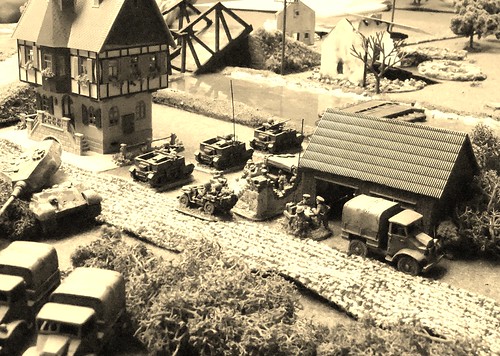 |
| The Canadians reinforce the fragile bridgehead. Note the Kingtiger destroyed in the last game |
The Canadians have two rifle platoons, with two Vickers MMGs and two 6 pounders and a carrier patrol over the river. A third rifle platoon is coming up to cross. Giving supporting fire from across the canal is a troop of Shermans. There is also a FOO. Mike failed his die roll for air support. Presumably bad weather has grounded the fighter bombers that gave me such a headache in last year's game!
The Fallschirmjaeger are attacking with two rifle platoons and two platoons of StuGs supported by an MG42 MMG platoon, a 75mm Infantry gun section (I rolled to randomly decide between them or the sexier 150mm recoilless rifles), a FOO calling in 120mm mortars and the company HQ with it's own 80mm mortars.
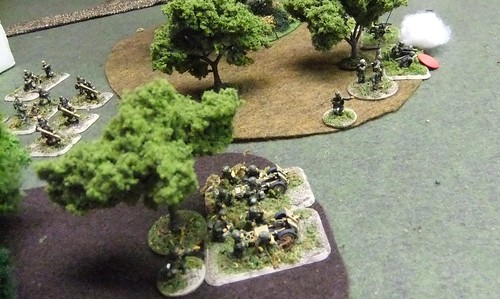 |
| German base of fire |
 |
| FJ assault from orchard |
Mike put both his rifle platoons with the 6 pounders and Vickers guns in the shelled houses at the foot of the blown bridge. The carrier patrol covered the right of the pontoon bridge.
 |
| StuGs give close support |
Brian was not really able to develop a full strength assault and pushed into the edge of the village with one section who easily drove out the pinned Canadians. But they were in turn counterattacked and driven back with heavy casualties. A second attack retook the rubble. The one platoon of StuGs formed on the German left and engaged the carrier patrol and the Shermans over the canal. The long range and small size of the carriers enabled them to survive for far longer than was thought possible. The second StuG platoon pushed up the road to give the Fallschirmjaeger some close support.
At this point the Canadian FOO was finally able to activate his artillery support and brought in a battery of 25 pounders onto the StuGs causing a mobility kill and lots of shock. The third rifle platoon was also able to get across the pontoon bridge and reinforce what was left (which wasn't much).
It was by now 0230 hrs and time to wrap the game up. The FJ could still crush the bridgehead with their weight of armour but their rifle platoons had taken 50% casualties. I think the battle would be decided by the FOO and the HQ set up by the pontoon bridge; how quickly could they get more reinforcements up and how much artillery could the FOO bring down to cordon off the perimeter?
To tweak the scenario I would have added a special card to randomly decide if some more Canadians show up to reinforce. Some armoured car sections or carrier patrols that had been scouting along the canal could have come back or more Shermans arrive to give more supporting fire.
Figures are all 15mm (a mix of Peter Pig, Battlefront and Old Glory) from my collection. We used I Ain't Been Shot, Mum 3rd edition rules with the Battle for Liberation army lists.
Monday, August 13, 2012
Wyrd Sisters
Thunder and lightning. Enter three Witches.
First Witch:
When shall we three meet again?
In thunder. lightning, or in rain?
Second Witch:
When the hurlyburly's done.
When the battle's lost and won.
(MacBeth Act 1 Scene I)
My buddy Dan gifted me this rather cool vignette a few years back. They had been kicking about in my 'things to do box' slowly getting primed and put away, then painted and put away, then based and put away. I showed them to you here way back in November 2010!
Finally this week while waiting for the primer to set on a commission I finished up their scenic elements. The standing stone is made from an off cut of blue insulating foam and the toadstools are made from wire and putty.
The witches came from RAFM on a rather thick shallow T shaped base with square slots for their stands to set into. I glued this to some card and built an edge around it with match sticks and then filled in the space with caulking. It then sat in my box of things to do for so long (4+ years??) that the caulking had yellowed and shrunk a bit! Some of the mushrooms lost their caps and needed replacing. The standing stone is pinned into the caulking with glue and a toothpick to give it a bit more strength.
I think the standing stone was probably the main thing holding this up. Once I set down to finish it the piece came together very quickly.
These will inevitably support Fulk the Bastard in his campaign to overthrow Goodly Count Raymond and the Countess Isabelle. Perhaps they can remove shock from friendly troops or inflict shock on enemy units? Or just look cool as rear area table dressing?
First Witch:
When shall we three meet again?
In thunder. lightning, or in rain?
Second Witch:
When the hurlyburly's done.
When the battle's lost and won.
(MacBeth Act 1 Scene I)
My buddy Dan gifted me this rather cool vignette a few years back. They had been kicking about in my 'things to do box' slowly getting primed and put away, then painted and put away, then based and put away. I showed them to you here way back in November 2010!
Finally this week while waiting for the primer to set on a commission I finished up their scenic elements. The standing stone is made from an off cut of blue insulating foam and the toadstools are made from wire and putty.
The witches came from RAFM on a rather thick shallow T shaped base with square slots for their stands to set into. I glued this to some card and built an edge around it with match sticks and then filled in the space with caulking. It then sat in my box of things to do for so long (4+ years??) that the caulking had yellowed and shrunk a bit! Some of the mushrooms lost their caps and needed replacing. The standing stone is pinned into the caulking with glue and a toothpick to give it a bit more strength.
 |
| Where hast thou been sister? Killing swine. |
I think the standing stone was probably the main thing holding this up. Once I set down to finish it the piece came together very quickly.
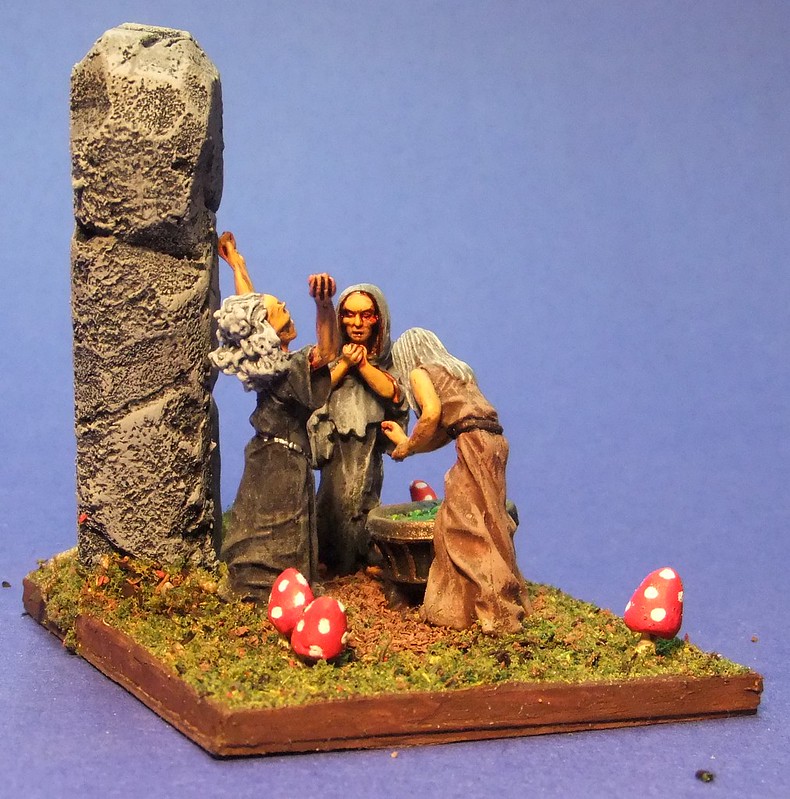 |
| The second witch |
 |
| Can't get a view of the third witch's face. |
These will inevitably support Fulk the Bastard in his campaign to overthrow Goodly Count Raymond and the Countess Isabelle. Perhaps they can remove shock from friendly troops or inflict shock on enemy units? Or just look cool as rear area table dressing?
 |
| A drum. A drum! Macbeth doth come! |
Labels:
Blood and Chivalry,
Gaming,
Hail Caesar,
Medieval,
Painting Bench
Thursday, August 9, 2012
jmlogo
 Well here's our shiney new logo. Now if I can just figure out how to put it up as a button on the side we'll be all set. Had one before but now stupid Blogger won't let me load any photos and tells me my URLs to my Flickr album are 'invalid'.... Grrrr.
Well here's our shiney new logo. Now if I can just figure out how to put it up as a button on the side we'll be all set. Had one before but now stupid Blogger won't let me load any photos and tells me my URLs to my Flickr album are 'invalid'.... Grrrr.jmlogo, a photo by Hotlead2009 on Flickr.
Tuesday, August 7, 2012
A Winter's Battle
A couple of weeks ago Dan came over for a game. His Viking/Prussian host is based for the winter so he brought his white fleece and we had a winter battle using my post Christmas sale trees. He put together a 10 unit army which fit very nicely into the Hail Caesar Army Lists volume 2 list for Vikings. He had 1 unit of huscarls as bodyguard to his warlord, 2 units of hirdmen, 5 units of bondi and 2 units of bondi archers. I fielded my early feudal/Norman/First Crusade army and used the Norman army list and also fielded 10 units. 2 knights, 2 mounted retainers/serjeants, 2 heavy infantry, 3 medium infantry and 1 medium archer. Units were 16 foot or 8 mounted.
I'll let one of the monks tell the tale:
From the Chronicles of the Monk Owsric
In the Year of Our Lord 1092 , during the first week of Advent, Fulk the Bastard, enemy of God, brought a host of Norsemen into the Realm. With fire and sword these sea wolves sacked the Monastery of St. Froebenius and carried off much treasure. They also captured the blessed Abbot Adhelbert to hold him for ransom.
An early snow fell but Count Raymond, friend of the Church and her children, called out his vassals to pursue the Norsemen and rescue the Abbot. The Red Knight, who was staying at the Count's castle for the Feast of Christmas, being a cavalier above reproach and champion of the tourney rode out with his liege and host. Henry the Lion also rode out from his neighbouring castle bringing many vassals with him.
By the village of Lapins dans l'Eau the Count caught up to the Seawolves as they were fording a river.
Henry the Lion commanded the chivalry on the left and the Red Knight commanded the chivalry on the right. The good Count commanded the infantry in the center.
With a cry of "For God, St. Frobenius and Mantovia!" the Count's army surged forward.
Henry and the Count attacked the rear of the Viking host while the Red Knight kept the rest of the Vikings from recrossing the river.
Arrows hissed and shield walls crashed together. Axes split helmets and shields. Spears impaled livers and the snow was turned red.
The levies from Hameau de Porc trembled at the Norse fury and ran. Count Raymond cried out "For the love of Christ, wilst thou leave me to fight the Seawolves on my own?" and rallied his men to close the breach in the line.
Shouting his Warcry, Henry the Lion's squadrons surged up the snowy slope to smash the Vikings before them, trampling many beneath their steeds. Meanwhile the Count's footmen smashed again and again into the Norse shieldwalls to finally break them.
But in his moment of triumph, a Norse spear struck the Lion, felling him from the saddle and putting his division into disarray and halting their pursuit of the shattered Seawolves.
Seeing the Vikings cross the river to aid their rearguard, the Red Knight charged into the shieldwall aiming for the Black Raven banner of the Viking Warlord, Danling Hutterskal the Red Axe. The Viking horde, like locusts swarmed around the flowers of Mantovian chivalry and cut them down.
Danling Red-Axe then spake to the Good Count "Enough! Enough of our shield brothers now sit in the halls of our ancestors. Take your man of God, for his sermons annoy me and we will return to our ships and our hearths and trouble you no more."
Count Raymond then spake "Leave my folk in peace. No farm nor hayrick shall be fired. You may buy your provisions with the gold you have taken and go."
The Seawolves then left Mantovia and the folk had peace for Christmas.
So Dan and I fought each other to a bloody nail biting conclusion. Both armies were battered and in bad positions relative to the other so we figured they would negotiate a truce. It was nice for both of us to get our respective armies out again.
My army is mostly Old Glory Normans and First Crusade with some Gripping Beast and a few Ral Partha. Dan's army is meant to be Prussians to fight his Teutonic Knights, but they work as Vikings too. He's been building it for years so it is a melange of manufacturers.
I was quite pleased with how good a game we got using Hail Caesar for this era and we both felt the lists worked quite well giving nice little armies that reflected our opinions about how the historical armies should have looked.
Now I need to go inventory what other Norman figures I have in my lead pile before I'm tempted to buy some of Conquest Game's new plastic Norman foot!
I'll let one of the monks tell the tale:
From the Chronicles of the Monk Owsric
In the Year of Our Lord 1092 , during the first week of Advent, Fulk the Bastard, enemy of God, brought a host of Norsemen into the Realm. With fire and sword these sea wolves sacked the Monastery of St. Froebenius and carried off much treasure. They also captured the blessed Abbot Adhelbert to hold him for ransom.
An early snow fell but Count Raymond, friend of the Church and her children, called out his vassals to pursue the Norsemen and rescue the Abbot. The Red Knight, who was staying at the Count's castle for the Feast of Christmas, being a cavalier above reproach and champion of the tourney rode out with his liege and host. Henry the Lion also rode out from his neighbouring castle bringing many vassals with him.
By the village of Lapins dans l'Eau the Count caught up to the Seawolves as they were fording a river.
 |
| The Count's army deploys |
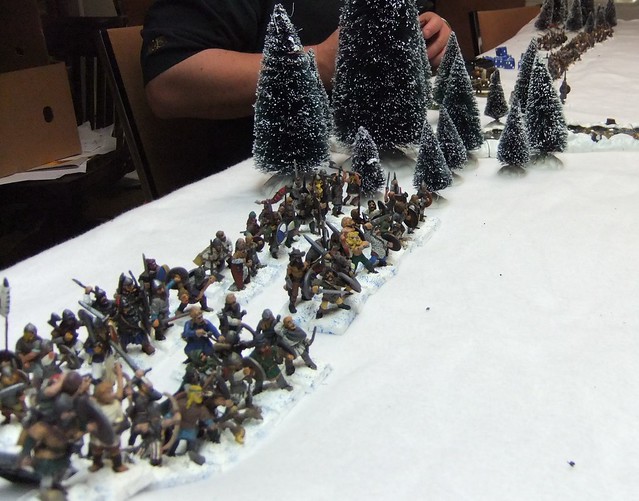 |
| The Vikings deploy |
 |
| View of Viking center with Abbot and loot |
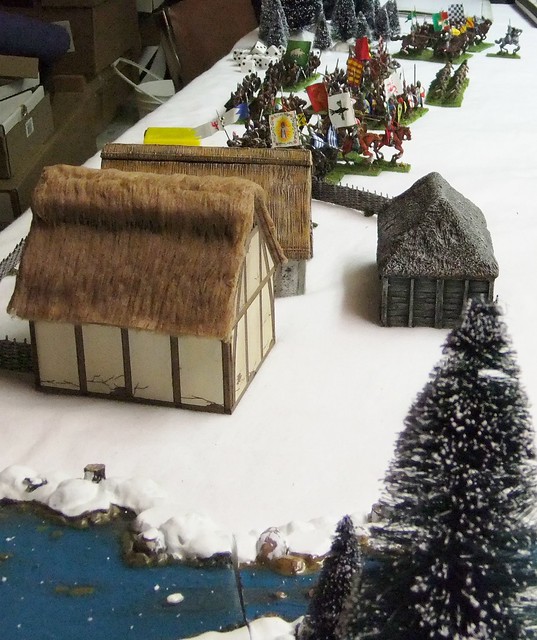 |
| My new village in it's first game! |
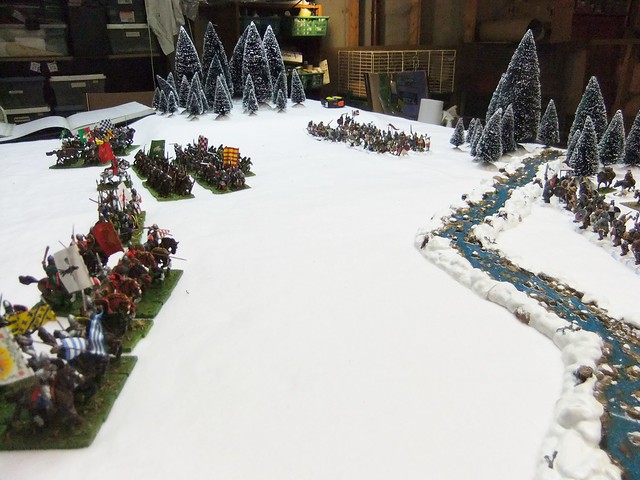 |
| Opening moves- the Count's army advances |
Arrows hissed and shield walls crashed together. Axes split helmets and shields. Spears impaled livers and the snow was turned red.
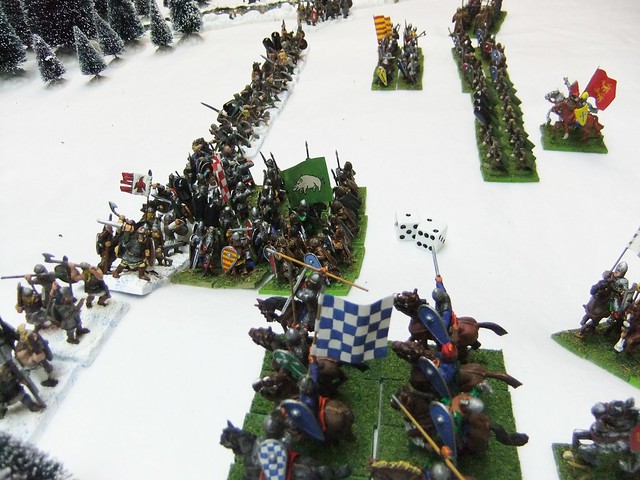 |
| First clash and first break test. Lost by only figure too! |
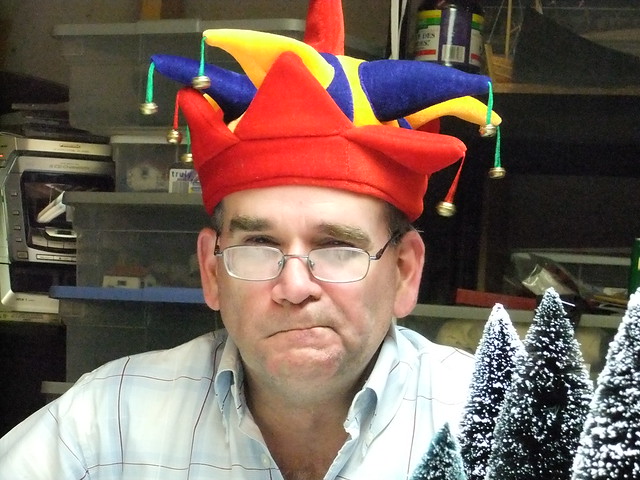 |
| We have a Jester's Cap for when things go that badly. You can tell I'm pleased! |
Shouting his Warcry, Henry the Lion's squadrons surged up the snowy slope to smash the Vikings before them, trampling many beneath their steeds. Meanwhile the Count's footmen smashed again and again into the Norse shieldwalls to finally break them.
But in his moment of triumph, a Norse spear struck the Lion, felling him from the saddle and putting his division into disarray and halting their pursuit of the shattered Seawolves.
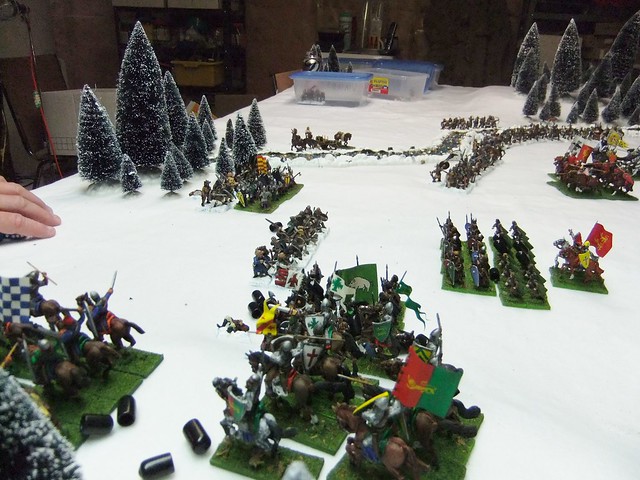 |
| Overrunning the Viking right wing |
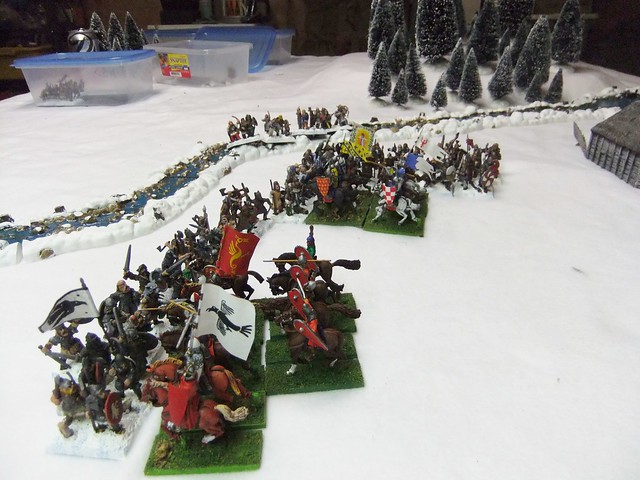 |
| Death of the Mantovian right wing! |
Count Raymond then spake "Leave my folk in peace. No farm nor hayrick shall be fired. You may buy your provisions with the gold you have taken and go."
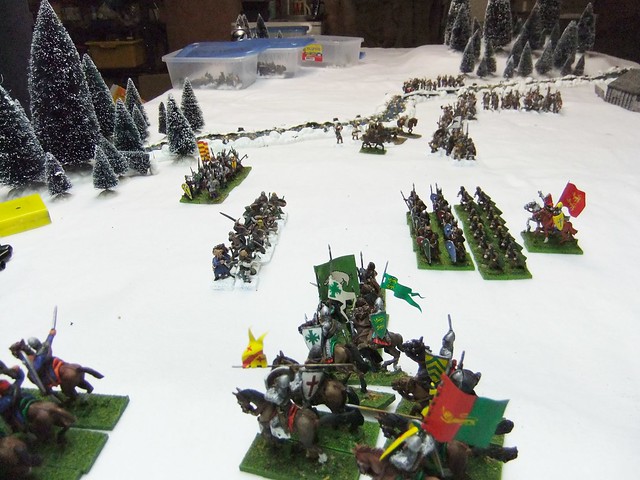 |
| Endgame |
The Seawolves then left Mantovia and the folk had peace for Christmas.
So Dan and I fought each other to a bloody nail biting conclusion. Both armies were battered and in bad positions relative to the other so we figured they would negotiate a truce. It was nice for both of us to get our respective armies out again.
My army is mostly Old Glory Normans and First Crusade with some Gripping Beast and a few Ral Partha. Dan's army is meant to be Prussians to fight his Teutonic Knights, but they work as Vikings too. He's been building it for years so it is a melange of manufacturers.
I was quite pleased with how good a game we got using Hail Caesar for this era and we both felt the lists worked quite well giving nice little armies that reflected our opinions about how the historical armies should have looked.
Now I need to go inventory what other Norman figures I have in my lead pile before I'm tempted to buy some of Conquest Game's new plastic Norman foot!
Subscribe to:
Posts (Atom)

